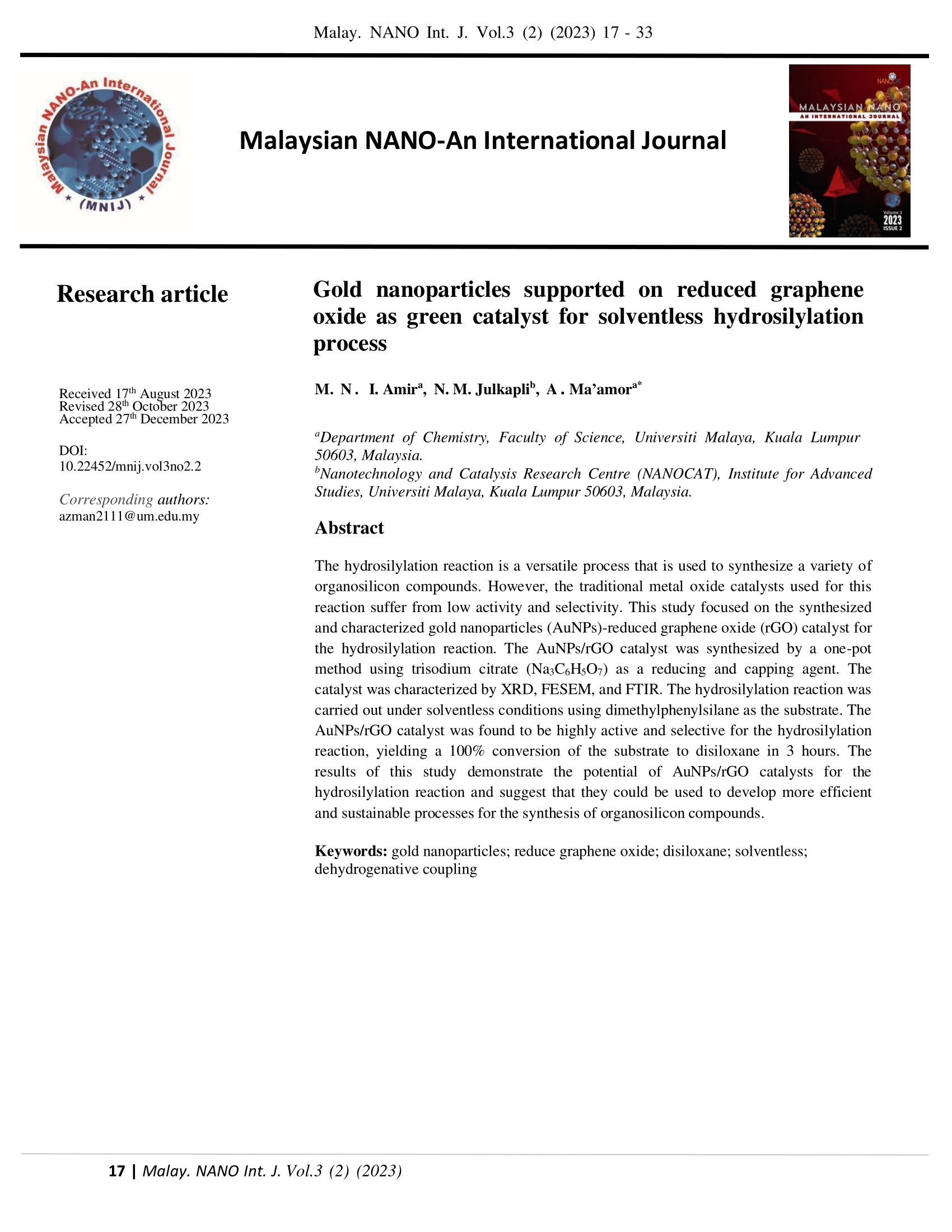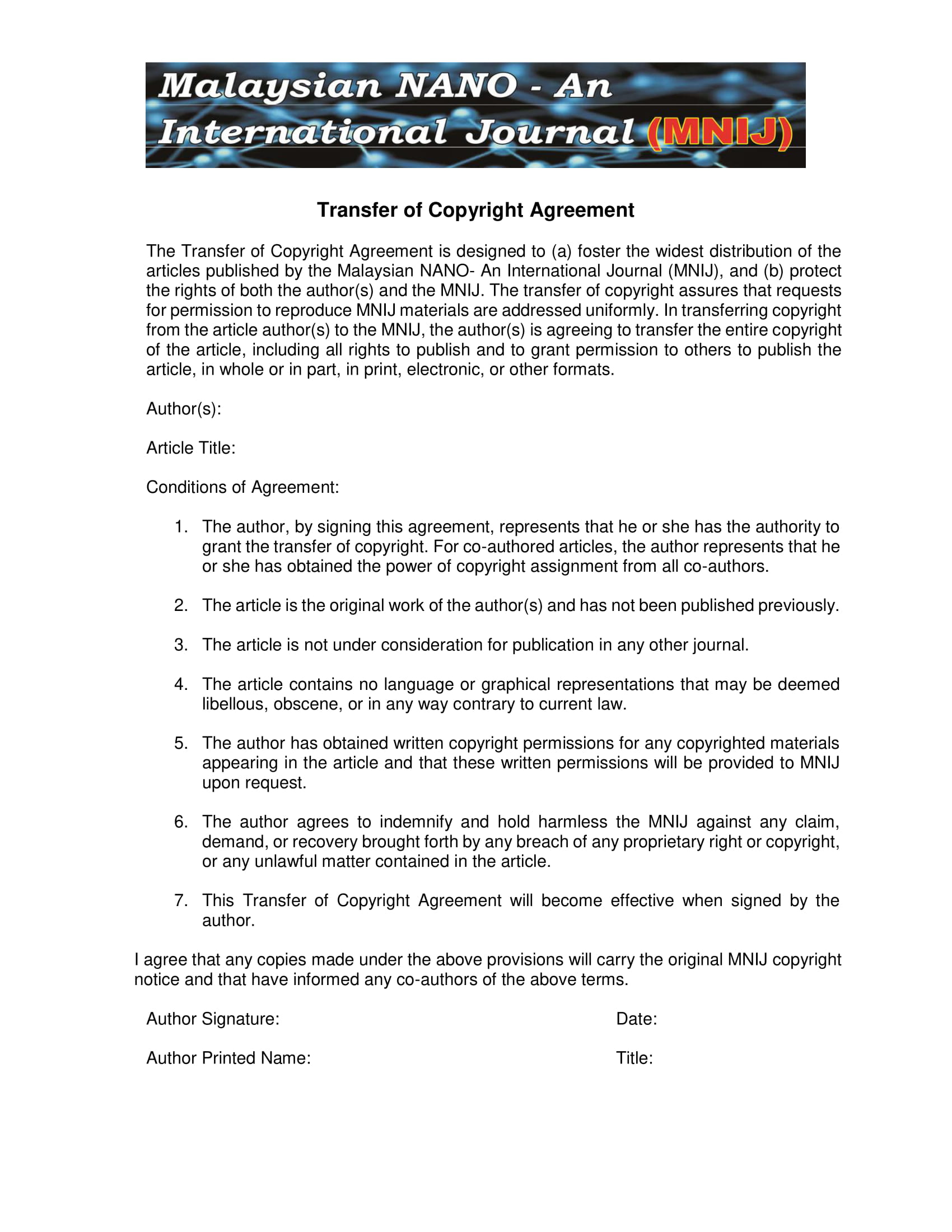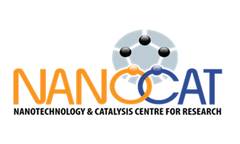Gold nanoparticles supported on reduced graphene oxide as green catalyst for solventless hydrosilylation process
DOI:
https://doi.org/10.22452/mnij.vol3no2.2Keywords:
gold nanoparticles, reduce graphene oxide, disiloxane, solventless, dehydrogenative couplingAbstract
The hydrosilylation reaction is a versatile process that is used to synthesize a variety of organosilicon compounds. However, the traditional metal oxide catalysts used for this reaction suffer from low activity and selectivity. In this study, we synthesized and characterized a gold nanoparticles (AuNPs)-reduced graphene oxide (rGO) catalyst for the hydrosilylation reaction. The AuNPs-rGO catalyst was synthesized by a one-pot method using trisodium citrate (Na3C6H5O7) as a reducing and capping agent. The catalyst was characterized by XRD, FESEM, and FTIR. The hydrosilylation reaction was carried out under solventless conditions using dimethylphenylsilane as the substrate. The AuNPs-rGO catalyst was found to be highly active and selective for the hydrosilylation reaction, yielding a 100% conversion of the substrate to disiloxane in 3 hours. The results of this study demonstrate the potential of AuNPs-rGO catalysts for the hydrosilylation reaction and suggest that they could be used to develop more efficient and sustainable processes for the synthesis of organosilicon compounds.
Downloads
References
Okuhara, T., Water-tolerant solid acid catalysts. Chemical reviews, 2002. 102(10): p. 3641-3666.
Hattori, H., Solid base catalysts: generation of basic sites and application to organic synthesis. Applied Catalysis A: General, 2001. 222(1-2): p. 247-259.
Chiusoli, G.P. and P.M. Maitlis, Metal-catalysis in industrial organic processes. 2019: Royal Society of Chemistry.
Mashayekhi, N.A., M.C. Kung, and H.H. Kung, Selective oxidation of hydrocarbons on supported Au catalysts. Catalysis Today, 2014. 238: p. 74-79.
Zhang, S., et al., Recent advances of the combination of Au/acid catalysis. Chinese Journal of Chemistry, 2014. 32(10): p. 937-956.
Padwa, A., Rhodium (II) mediated cyclizations of diazo alkynyl ketones. Journal of Organometallic Chemistry, 2000. 610(1-2): p. 88-101.
Akutagawa, S., Asymmetric synthesis by metal BINAP catalysts. Applied Catalysis A: General, 1995. 128(2): p. 171-207.
Kim, S.B., Catalysis Application of Metal (Rh, Ir) Quinonoid Complexes. Journal of Inorganic and Organometallic Polymers and Materials, 2014. 24(1): p. 58-65.
Suchorski, Y. and W. Drachsel, Catalytic reactions on platinum nanofacets: bridging the size and complexity gap. Topics in Catalysis, 2007. 46(1): p. 201-215.
Blaser, H.-U., et al., Enantioselective hydrogenation of α-ketoesters using cinchona modified platinum catalysts and related systems: a review. Catalysis today, 1997. 37(4): p. 441-463.
Lohray, B. and V. Bhushan, in Enantioselective Catalysis. Organic Synthesis Highlights III, 1998. 3: p. 44.
Rueping, M. and B.J. Nachtsheim, A review of new developments in the Friedel–Crafts alkylation–From green chemistry to asymmetric catalysis. Beilstein Journal of Organic Chemistry, 2010. 6(1): p. 6.
Torrent, M., et al., Density functional study of the [2+ 2]-and [2+ 3]-cycloaddition mechanisms for the osmium-catalyzed dihydroxylation of olefins. Organometallics, 1997. 16(1): p. 13-19.
Ishihara, A., et al., Tantalum oxide-based compounds as new non-noble cathodes for polymer electrolyte fuel cell. Electrochimica Acta, 2010. 55(26): p. 7581-7589.
Kidonakis, M. and M. Stratakis, Ligandless regioselective hydrosilylation of allenes catalyzed by gold nanoparticles. Organic letters, 2015. 17(18): p. 4538-4541.
Lantos, D., et al., Homogeneous gold-catalyzed hydrosilylation of aldehydes. Journal of organometallic chemistry, 2007. 692(9): p. 1799-1805.
Diez-Gonzalez, S. and S.P. Nolan, Copper, silver, and gold complexes in hydrosilylation reactions. Accounts of chemical research, 2008. 41(2): p. 349-358.
Nijamudheen, A. and A. Datta, Gold‐Catalyzed Cross‐Coupling Reactions: An Overview of Design Strategies, Mechanistic Studies, and Applications. Chemistry–A European Journal, 2020. 26(7): p. 1442-1487.
Liu, P. and J. Sun, Stereoselective Synthesis of Tetrasubstituted Furylalkenes via Gold-Catalyzed Cross-Coupling of Enynones with Diazo Compounds. Organic letters, 2017. 19(13): p. 3482-3485.
Garcia, P., et al., Gold-catalyzed cross-couplings: new opportunities for CC bond formation. ChemInform, 2010. 41(30): p. i.
Echavarren, A.M., A.S.K. Hashmi, and F.D. Toste, Gold catalysis–steadily increasing in importance. Advanced Synthesis & Catalysis, 2016. 358(9): p. 1347-1347.
Tomas-Mendivil, E., et al., Gold-Catalyzed Access to 1 H-Isochromenes: Reaction Development and Mechanistic Insight. ACS Catalysis, 2017. 7(1): p. 380-387.
Liang, S., et al., Commercial Supported Gold Nanoparticles Catalyzed Alkyne Hydroamination and Indole Synthesis. Advanced Synthesis & Catalysis, 2016. 358(20): p. 3313-3318.
Marinoiu, A., et al., Low-cost preparation method of well dispersed gold nanoparticles on reduced graphene oxide and electrocatalytic stability in PEM fuel cell. Arabian Journal of Chemistry, 2020. 13(1): p. 3585-3600.
Stegelmann, C., et al., Microkinetic modeling of ethylene oxidation over silver. Journal of Catalysis, 2004. 221(2): p. 630-649.
Goncharova, S., E. Paukshtis, and B. Bal'Zhinimaev, Size effects in ethylene oxidation on silver catalysts. Influence of support and Cs promoter. Applied Catalysis A: General, 1995. 126(1): p. 67-84.
Sawama, Y., et al., Disiloxane Synthesis Based on Silicon–Hydrogen Bond Activation using Gold and Platinum on Carbon in Water or Heavy Water. The Journal of Organic Chemistry, 2016. 81(10): p. 4190-4195.
Lyons, T.W. and M.S. Sanford, Palladium-catalyzed ligand-directed C− H functionalization reactions. Chemical reviews, 2010. 110(2): p. 1147-1169.
Littke, A.F. and G.C. Fu, Palladium‐catalyzed coupling reactions of aryl chlorides. Angewandte Chemie International Edition, 2002. 41(22): p. 4176-4211.
Blandez, J.F., et al., Palladium nanoparticles supported on graphene as catalysts for the dehydrogenative coupling of hydrosilanes and amines. Catalysis Science & Technology, 2015. 5(4): p. 2167-2173.
Blandez, J.F., et al., Nickel nanoparticles supported on graphene as catalysts for aldehyde hydrosilylation. Journal of Molecular Catalysis A: Chemical, 2016. 412: p. 13-19.
Biradar, A.V. and T. Asefa, Nanosized gold-catalyzed selective oxidation of alkyl-substituted benzenes and n-alkanes. Applied Catalysis A: General, 2012. 435: p. 19-26.
Marcano, D.C., et al., Improved synthesis of graphene oxide. ACS nano, 2010. 4(8): p. 4806-4814.
Zhang, Z., et al., Sodium citrate: A universal reducing agent for reduction/decoration of graphene oxide with au nanoparticles. Nano Research, 2011. 4(6): p. 599-611.
Chuang, M.-K., et al., Gold nanoparticle-decorated graphene oxides for plasmonic-enhanced polymer photovoltaic devices. Nanoscale, 2014. 6(3): p. 1573-1579.
Amir, M.N.I., et al., Tuning lattice strain in Quasi-2D Au-rGO nanohybrid catalysts for dimethylphenylsilane solid state silylation to disiloxane. Materials Science and Engineering: B, 2023. 291: p. 116395
Krishnamurthy, S., et al., Yucca-derived synthesis of gold nanomaterial and their catalytic potential. Nanoscale research letters, 2014. 9(1): p. 627.
García, C.P., et al., Microscopic analysis of the interaction of gold nanoparticles with cells of the innate immune system. Scientific Reports, 2013. 3(1): p. 1-7.
Shang, L., et al., Graphene‐supported ultrafine metal nanoparticles encapsulated by mesoporous silica: robust catalysts for oxidation and reduction reactions. Angewandte Chemie, 2014. 126(1): p. 254-258.
Emiru, T.F. and D.W. Ayele, Controlled synthesis, characterization and reduction of graphene oxide: A convenient method for large scale production. Egyptian Journal of Basic and Applied Sciences, 2017. 4(1): p. 74-79.
Amanulla, B., et al., Selective colorimetric detection of nitrite in water using chitosan stabilized gold nanoparticles decorated reduced graphene oxide. Scientific Reports, 2017. 7(1): p. 1-9.
Tran, T.D., et al., Gold nanoparticles as an outstanding catalyst for the hydrogen evolution reaction. Chemical Communications, 2018. 54(27): p. 3363-3366.
Mohan, J.C., et al., Functionalised gold nanoparticles for selective induction of in vitro apoptosis among human cancer cell lines. Journal of experimental nanoscience, 2013. 8(1): p. 32-4
Tanaka, K. and F. Toda, Solvent-Free Organic Reactions. Chem. Rev, 2000. 100: p. 1025-1074.
Loupy, A., Solvent-free reactions, in Modern Solvents in Organic Synthesis. 1999, Springer. p. 153-207.

Downloads
Published
How to Cite
Issue
Section
License





